JUDAS GHOST LURES GHOST HUNTERS
by Thomas M. Sipos, managing editor [July 24, 2014]
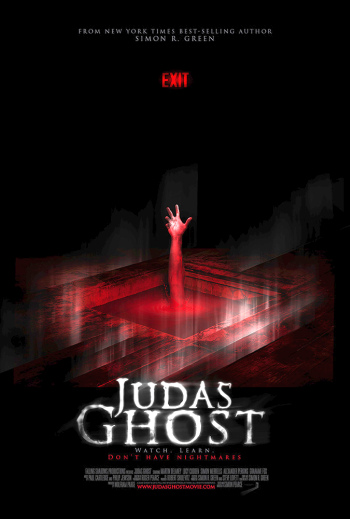 [HollywoodInvestigator.com] Like many low-budget films, Judas Ghost features a handful of characters kept to one location. Not a summer camp, or even a house, but a room. Four people in one room. For the entire film. Granted, it's a large room. [HollywoodInvestigator.com] Like many low-budget films, Judas Ghost features a handful of characters kept to one location. Not a summer camp, or even a house, but a room. Four people in one room. For the entire film. Granted, it's a large room.
The film's story begins without exposition. The four enter a large, empty institutional room and begin their work. Skipping the affectionately teasing introductions so common in SyFy Channel monster movies -- "This is Jim, our resident marine biologist and beer drinking champ, woo-hoo!" -- we must learn who these people are, and what they're doing, from their conversation.
We learn they work for an "institute" that investigates the paranormal. We never learn whether this institute is affiliated with a university, a government, or is privately funded, but it seems to be rich and powerful, hierarchically organized, enforcing strict discipline. Perhaps Fox Mulder's dreams of what The X-Files could be were it properly funded. The institute in Poltergeist: The Legacy also comes to mind.
Their assignment appears mundane. Record some training tapes in a room reputed to be haunted. The sort of routine manifestation easily handled by rookies. The investigators wonder about their talents being wasted on grunt work. But as so often the case with powerful, secretive organizations, events reveal that our team was lied to. This is no routine haunting...
Of Simon Green's screenplay for Judas Ghost, director Simon Pearce says its premise "originates from the Ghost Finder novels. It's a new group of characters but set in the same universe, which revolves around a top secret government organization known as the Carnacki Institute, set up to combat the dead."
Pearce met Green in 2010. They discussed collaborating on a film based on Green's sci-fi script, The Crooked Man, but it proved too expensive. So they and producer Wolfram Parge "discussed ideas for films smaller in scale, utilizing fewer characters and locations, like REC, Saw, Paranormal Activity, and The Blair With Project. I liked that Judas Ghost was a throwback to ghost stories of old, albeit with a modern twist, bucking the trend of torture porn. I was a relative newcomer to horror, so this was a challenge. Certainly a lot of older, traditional ghost stories were an influence -- John Carpenter's The Prince of Darkness and The Haunting."
As in The X-Files and Cube 2, while the investigators are on the side of good, that's not always true of their superiors. "In the books, Simon had started to set up that there was some sort of conspiracy at the Institute," Pearce explained. "That’s when we had the idea to suggest something nefarious might be happening that our characters don’t know about. I liked the idea of this sinister, all seeing eye, represented by the web-cam, watching over them, with us not knowing who or what might be on the other end."
Judas Ghost's investigators are top notch professionals, and I initially disliked their bad-ass, full-of-themselves attitude. Team leader Jerry (Martin Delaney) starts off as cocky, dismissive of Mark (Simon Merrells), and lectures for the training tapes in a bored, above-it-all manner. Psychic Anna (Lucy Cudden) reads people's minds, and when they object, she snarkily says they "shouldn't think so loud." She calls people sweetie and dear in a disrespectful tone. She rubbed me the wrong way. I don't know if I was meant to dislike Jerry and Anna at first, but I did.
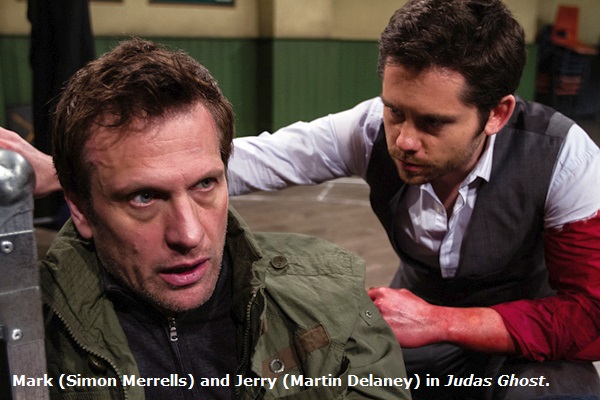
But as they discover their abilities are no match for the evil they confront, they grow by being humbled, revealing their better sides. Jerry's sole concern becomes his team's safety. He pleads with Mark that they can't survive without his help. (Mark is a lowly cameraman, recently released from an asylum, who, it turns out, had a previous run-in with the evil entity.) Anna is frantic with remorse over the loss of Ian.
These character arcs enrich the story, though I still felt largely uninvolved, like an outsider watching stick figures go through the motions. This is partially because it took me a while to warm up to them, but also due to Judas Ghost's fast, video game pace. The quick succession of ghostly attacks leave little time to ruminate over the protagonists. As in many genre films, emphasis is on plot rather than character.
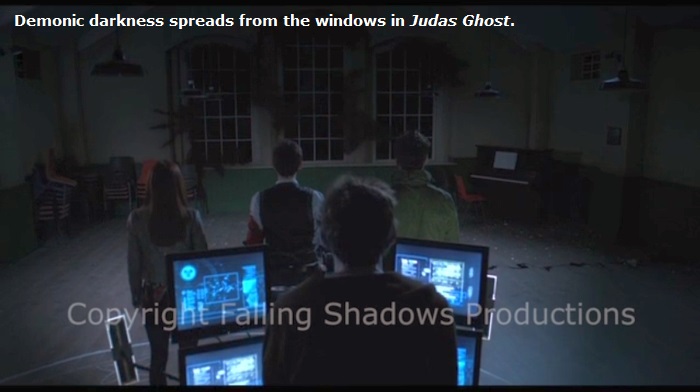
Pearce is a capable director. He makes efficient use of his limited space with a dynamic camera that glides among well-staged actors, creating nicely composed shots.
Judas Ghost is as polished as any big studio film. The money saved on cast and location appears to have been well spent on production costs. Visual effects are impressive if unoriginal (e.g., blackness spreading across a room, and a vat of blood, are common horror film tropes.)
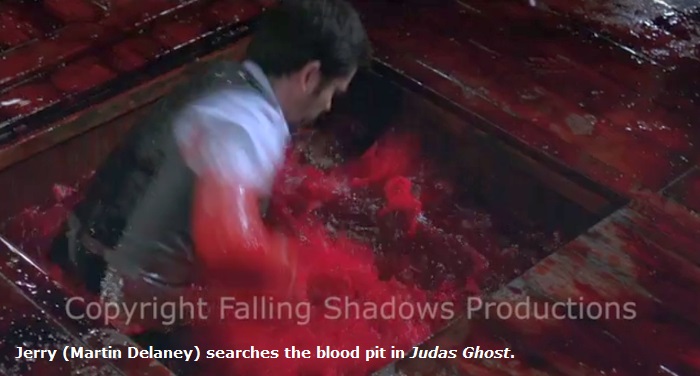
Creating good visual effects was eased by renting a professional studio. "The location was a built set at Vision Studios in Portishead," said Pearce. "We looked at existing village halls, but logistically couldn't see how we were going to pull it all off in a fixed space. But by building a set, we had total control and could move walls/doors as required, both for story and to help us move around the space with all the crew. We didn't have to worry about things like weather or light, which usually slows down a shoot. We also didn't have to worry anytime we had to throw blood around!
"While the set was expensive, in terms of budget it did help. Having control saved us time. We had space upstairs to house our actors. The set was built under the same roof as the company loaning us all our lights and grip equipment. Everything we needed was literally on the doorstep."
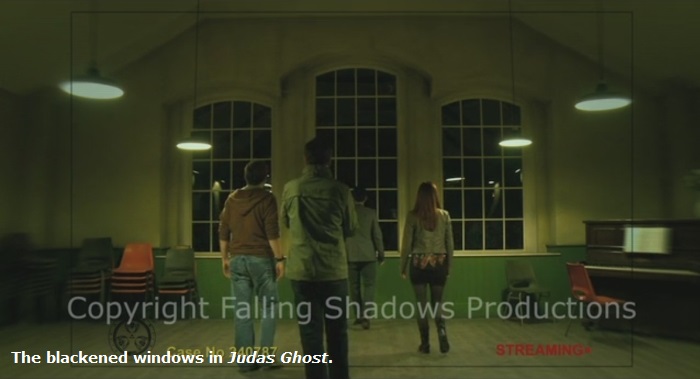
One of the creepier, claustrophobia-enhancing effects was the sudden pitch blackness beyond the windows, an effect harder to create than one might imagine. "The reflections were awkward, and on a lot of the wider shots some visual effects work had to be done to correct them and remove a light or stray crew member. Shooting towards the windows was tricky." But, says Pearce, filming inside a studio helped. "A set made blacking out the windows relatively straightforward. A wrap around drape to hang on the other side, with enough room in between that and the windows for lights and stands when needed."
Spooky noise effects and mood music further enhance Judas Ghost's atmosphere and pace, even if at times they get overly dramatic and overly loud.

The cast is professional and perform well in their roles. "Initially Wolfram and I tried to cast the film ourselves," said Pearce, "by putting casting calls online. But after hundreds of responses and two rounds of auditions in London, we realized we didn't have the time or resources to do this. What we were after was quite specific. We were going to be asking a lot of our cast. They would be onscreen for the entire movie. They carry the movie. The characters themselves are all a little larger than life. They inhabit this fantastical world, but audiences need to buy them as people and relate to them." Pearce hired London-based casting agents Shakyra Dowling and Kristina Erdely, who found the right actors.
Judas Ghost was shot on an ARRI Alexa camera, "with a Sony EX3 standing in for the handheld camera that Mark operates in the film." The film was edited on Final Cut Pro. Visual effects are by Peerless Camera Company in London, whose credits include Skyfall and Green Lantern. Pearce praises Wolfram for the "major coup of getting them on board."
The IMDb reports a budget of 200,000 pound. "The money had been raised privately through Green’s book sales," says Pearce. Even so, "We still had to call in a lot of favors to get it done. It's testament to everyone involved that we were able to produce what I think is such a technically polished final product."

Judas Ghost has played at film festivals in Europe and the U.S. "We are being represented for international sales by Stealth Media. Having taken the film to Cannes last May, we have a deal with a UK distributor pending, which I hope to announce officially in the next few weeks, and a potential US deal. The film should be out on VOD around October/November this year and on DVD by early 2015."
Details about Judas Ghost can be found on their website.
|
